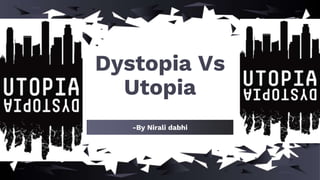
Dystopia Vs Utopia
- 1. -By Nirali dabhi Dystopia Vs Utopia
- 2. Introduction Name: Nirali Dabhi Roll number: 13 Enrollment Number: 4069206420220006 Sem: 2 M.A Paper number: 107 Paper Name: The Twentieth Century Literature: From World War II to the End of the Century Topic: Dystopia vs Utopia Submitted to: Smt S.B. Gardi, Department of English, M.K.B.U Email: niralidabhi95@gmail.com
- 3. 01 Introduction of Dystopia and Utopia TABLE OF CONTENTS 02 Characteristics of Dystopia 03 Differences of Dystopia and Utopia Real-world Examples of Dystopia and Utopia 04 Characteristics of Utopia 05
- 4. Introduction of Dystopia and Utopia Utopia is the ideal state of society, where no distress prevails. Society there is full of prospects and opportunities, and no one is unhappy or hopeless there. Utopian society possesses almost perfect qualities for its citizens. Money is abolished, and citizens do the work they enjoy. (Smith) Dystopia is the opposite of Utopia, where everything is chaotic and disordered, nothing is good there, and it is not desirable at all. Dystopia shows the declination of society. Dystopian society is dehumanized, filled with tyrannical governments, and faces environmental disasters.(Smith)
- 5. Characteristics of Dystopia ● A dystopia is an imagined community or society that is dehumanizing and frightening. A dystopia is an antonym of a utopia, which is a perfect society.(Anderson) Characteristics 1. Government control: Government plays a significant role in dystopian literature. Generally, there is either no government or an oppressive ruling body. 2. Survival: The oppressive powers and destruction in dystopian worlds often leave the inhabitants to fend for themselves. 3. Technological control: Advanced science and technology in dystopian works go beyond tools for improving everyday life—technology is often depicted as a controlling, omnipresent force and is often a fear-mongering tactic.(Anderson)
- 6. ● Novel by Aldous Huxley - 1932 ● Movie - 1998 ● Explores the danger of technology. Brave New World 1984 ● Novel by George Orwell ● The world is under complete government control. ● Novel by Suzanne Collins ● Also a film series ● The fictional world of Panem, a future nation on the ruins of North America. Panem’s totalitarian government. The Hunger Games Examples of Dystopia
- 7. Characteristics of Utopia ● The term “utopia” was coined by Sir Thomas More in his 1516 book Utopia, which was about an ideal society on a fictional island.(Anderson) Characteristics ● Ecological utopia stories present worlds where climate and natural resources no longer face the dire crises they do today. ● Feminist utopias offer worlds where women and men are fully equal. ● Technological utopias depict advancements in computing, robotics, and transportation that are mere dreams in the present world. (Brown)
- 8. ● Novel by Thomas More Utopia The Giver ● Novel by Lois Lowry ● The Giver is American utopian science fiction movie, directed by Phillip Noyce. ● Novel By H. G. Wells Men Like God Examples of Utopia
- 9. ● Utopia is an imaginary society that is in perfect order. ● Utopia is guided by communism. ● Citizens are free from fear. ● Utopia is a disciplined society. It symbolizes paradise. ● Utopia is a systematic society. It is not controlled by constructed government systems. ● In a Utopia, citizens preserve nature.(Smith) ● Utopian fiction is set in a perfect world—an improved version of real life. (Brown) Dystopia ● Dystopia is a society that is disoriented and chaotic. ● Dystopia is under the control of a tyrannical government that keeps the citizens under constant surveillance. ● Citizens are frightened, and the situation is dreadful and horrible. ● Dystopia lacks discipline completely. It symbolizes hell. ● Dystopia is governed by a tyrannical government. ● Dystopia, nature is destroyed.(Smith) ● A dystopian novel drops its main character into a world where everything seems to have gone wrong at a macro level. (Brown) Utopia Differences
- 10. Differences… ● Both utopianism and dystopianism blur the boundary between fiction, philosophy, and political science. (Brown) ● Utopia and dystopia are two opposite concepts that are used to describe different types of societies. ● Utopia refers to an ideal society while dystopia refers to an imaginary place where life is extremely bad. ● Utopian societies have been proposed as a way to solve the problems of real- world societies while dystopian societies are often used in fiction as a warning about the dangers of unchecked technology or government power.
- 11. Real-world Examples of Dystopia and Utopia Dystopian Societies: ● North Korea ● Saudi Arabia ● China Utopian Societies: ● Bhutan ● Denmark
- 12. Work Cited ● Anderson, MT. “What Is Dystopian Fiction? 20 Examples of Dystopian Fiction - 2023.” MasterClass, 21 September 2022, https://www.masterclass.com/articles/what-is-dystopian-fiction-learn- about-the-5-characteristics-of-dystopian-fiction-with-examples. Accessed 11 March 2023. ● Brown, Dan. “What Is Utopian Literature? Examples of Utopia Fiction - 2023.” MasterClass, 29 September 2021, https://www.masterclass.com/articles/what-is-utopian-literature. Accessed 11 March 2023. ● Smith, Emma. “Difference Between Utopia and Dystopia.” AskAnyDifference.com, 24 February 2023, https://askanydifference.com/difference-between-utopia-and-dystopia/. Accessed 8 March 2023.